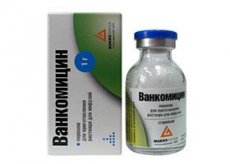Medical expert of the article
New publications
Preparations
Vancomycin
Last reviewed: 03.07.2025

All iLive content is medically reviewed or fact checked to ensure as much factual accuracy as possible.
We have strict sourcing guidelines and only link to reputable media sites, academic research institutions and, whenever possible, medically peer reviewed studies. Note that the numbers in parentheses ([1], [2], etc.) are clickable links to these studies.
If you feel that any of our content is inaccurate, out-of-date, or otherwise questionable, please select it and press Ctrl + Enter.

Vancomycin is a systemic glycopeptide antibiotic. Other trade names: Vancocin, Vancoled, Vanmixan.
Indications Vancomycin
Vancomycin is intended for systemic treatment of inflammations of infectious etiology: septicemia, peritonitis, retroperitoneal abscess, abscess of the lungs and mediastinum, meningitis, encephalitis, myelitis, acute endocarditis, osteomyelitis and pyogenic arthritis, pneumonia, pleurisy, enterocolitis. The use of Vancomycin is justified in cases of lack of antimicrobial effect of drugs of the penicillin, erythromycin or cephalosporin group.
Pharmacodynamics
The bactericidal action of vancomycin hydrochloride is due to its ability to bind to the amino acid components (acyl-D-alanyl-D-alanine) of the mucopeptide cytoplasmic membranes of bacteria, which disrupts their impermeability and inhibits RNA synthesis.
Vancomycin is effective against gram-positive microbes: staphylococci, streptococci, enterococci, clostridia, corynebacteria (C. diphtheriae), listeria, actinomycetes. However, this drug is not active against gram-negative microbes, mycobacteria, fungi and protozoa.
Pharmacokinetics
After intravenous administration of Vancomycin, more than half of the dose (55%) binds to plasma proteins; the drug enters the pleural, pericardial, synovial, cerebrospinal and other body fluids; penetrates the placental and blood-brain barrier.
The drug undergoes almost no biotransformation, and 70-80% of vancomycin hydrochloride is eliminated through the kidneys - with an average half-life of 4-8 hours. Excretion of the drug in patients with chronic renal failure occurs significantly longer.
Dosing and administration
Vancomycin should be administered parenterally by intravenous drip infusion – at a maximum rate of 10 mg per minute – over 60 minutes.
The standard daily dose for adults is 2 g (4 infusions of 500 mg or 2 administrations of 1 g at equal intervals).
The dose for pediatric patients is calculated at 10 mg per kilogram of body weight, the daily amount of the drug is administered 4 times (every 6 hours).
Use Vancomycin during pregnancy
Vancomycin is contraindicated during the first trimester of pregnancy; at later stages, the drug may be prescribed only if there are vital indications.
Contraindications
Contraindications to the use of Vancomycin include cochlear neuritis (inflammation of the auditory nerve), severe renal failure, first trimester of gestation, and breastfeeding. A relative contraindication is a history of hearing loss.
 [ 21 ]
[ 21 ]
Side effects Vancomycin
Side effects of Vancomycin include: pain and epidermal necrosis at the injection site; urticaria, dermatitis, inflammation of the walls of blood vessels; decreased blood pressure; fever; nausea; tinnitus and hearing loss; deterioration of kidney function (with the development of interstitial nephritis); changes in the blood (thrombocytopenia, agranulocytosis, eosinophilia, etc.).
With rapid administration of the drug, an anaphylactoid reaction occurs (skin hyperemia, pain and muscle spasms in the upper body).
Interactions with other drugs
Vancomycin is incompatible with β-lactam and aminoglycoside antibacterial drugs.
The simultaneous use of anesthetics, salicylates, and loop diuretics can cause anaphylactic shock.
Antihistamines, antipsychotics of the phenothiazine group, and thioxanthene derivatives prevent the detection of symptoms of hearing loss, one of the side effects of Vancomycin.
Shelf life
2 years.
 [ 47 ]
[ 47 ]
Attention!
To simplify the perception of information, this instruction for use of the drug "Vancomycin" translated and presented in a special form on the basis of the official instructions for medical use of the drug. Before use read the annotation that came directly to medicines.
Description provided for informational purposes and is not a guide to self-healing. The need for this drug, the purpose of the treatment regimen, methods and dose of the drug is determined solely by the attending physician. Self-medication is dangerous for your health.

